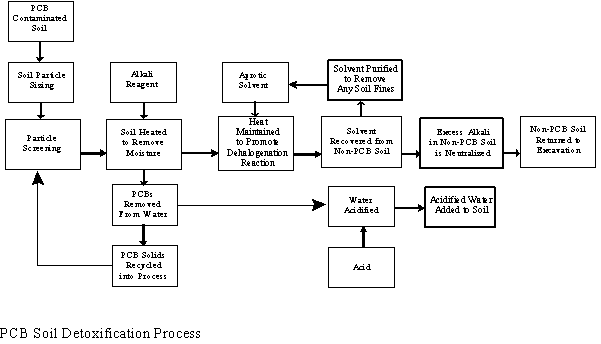
(PCB- and Organochlorine-Contaminated Soil Detoxification)
This technology uses an aprotic solvent, other reagents, and heat to dehalogenate polychlorinated biphenyls (PCB) in solids to inert biphenyl and chloride salts (see figure below). First, solid material is sized to allow better contact between the reagents and PCBs. In a continuous flow reactor, the soils are heated to drive off excess water. Reagents are then added to destroy the PCBs.

The reagent, consisting of a solvent and an inorganic alkali material, completely strips chlorine from the PCB molecule. Excess alkali can be easily neutralized and is reusable in the process. Treated soil can be returned to the excavation once analytical results show that PCBs have been destroyed.
Gas chromatography/mass spectroscopy analyses of processed PCB materials show that the process produces no toxic or hazardous products.
A chlorine balance confirms that PCBs are completely dehalogenated. To further confirm chemical dehalogenation, inorganic and total organic chloride analyses are also used. The average total chloride recovery for treated soils is greater than 90 percent.
The commercial process is expected to be less costly than incineration but more expensive than land disposal. Since no stack emissions are produced, permitting the process for a remediation would be easier than incineration.
The process can treat many different solid and sludge-type materials contaminated with PCB Aroclor mixtures, specific PCB congeners, pentachlorophenol, and individual chlorinated dioxin isomers. However, other chlorinated hydrocarbons such as pesticides, herbicides, and polychlorinated dibenzofurans could also be treated by this technology.
This technology was accepted into the SITE Emerging Technology Program in July 1990. The current system was developed by researchers in early 1991, after the original aqueous, caustic-based system proved ineffective at destroying PCBs.
The SITE project was completed in 1992. Trinity is investigating further improvements to the technology. Due to cost limitations, no commercialization of the investigated process is expected. A final report will not be published.
In bench-scale studies, synthetically contaminated materials have been processed to eliminate uncertainties in initial PCB concentration. This chemical process has reduced PCB concentrations from 2,000 parts per million (ppm) to less than 2 ppm in about 30 minutes using moderate power input. Further laboratory experiments are underway to determine the reaction mechanism and to enhance PCB destruction. Through additional experimentation, Trinity Environmental Technologies, Inc., expects to reduce processing time through better temperature control, more efficient mixing, and possibly more aggressive reagents.
A modular pilot-scale processor has been planned that uses several heating zones to preheat and dry the contaminated soil, followed by PCB destruction. The pilot process would be capable of processing 1 ton per hour initially. Additional modules could be added to increase process capacity, as needed. Contaminated soils from actual sites will be used to test the pilot-scale processor instead of the synthetically contaminated soils used in bench-scale testing.
EPA PROJECT MANAGER:
Paul dePercin
U.S. EPA
National Risk Management Research Laboratory
26 West Martin Luther King Drive
Cincinnati, OH 45268
513-569-7797
Fax: 513-569-7105
E-Mail:
dePercin.Paul@epamail.epa.gov
TECHNOLOGY DEVELOPER CONTACT:
Duane Koszalka
Trinity Environmental Technologies, Inc.
62 East First Street
Mound Valley, KS 67354
316-328-3222
Fax: 316-328-2033